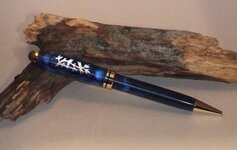TurnerJP
Member
Has anyone ever tried to do shell inlay on their pens? I know common inlays are veneer, metal and stone powders, and even ivory at times...but much a high end pool cue, I'm wondering if it is possible to do shell ivory (specifically mother of pearl and abalone) inlay into a pen?
How would one go about cutting a pattern out of shell and fitting it? I suppose that's a more general question than to the material specifically, but if anyone has had experience working with the stuff I'm all ears.
Thanks in advance,
JP
How would one go about cutting a pattern out of shell and fitting it? I suppose that's a more general question than to the material specifically, but if anyone has had experience working with the stuff I'm all ears.
Thanks in advance,
JP

